Livelihood Vulnerability and Adaptation Capacity of Rice Farmers under Climate Change and Environmental Pressure on the Vietnam Mekong Delta Floodplains
Abstract
1. Introduction
2. Study Area
3. Methods
3.1. Data Collection
3.2. Sampling Methods
3.3. Livelihood Vulnerability Assessment
3.3.1. Livelihood Vulnerability Index (LVI) Analysis
3.3.2. Calculating the LVI-IPCC
4. Results and Discussion
4.1. Farm and Farmer Characteristics
4.2. Vulnerability Assessment Using LVI and LVI-IPCC
4.3. Farmers’ Perceptions of Climate Change and Environmental Pressure
4.4. Adaptation Options in Farming Practices
4.5. Limitations and Future Outlooks
5. Conclusions
Author Contributions
Funding
Acknowledgments
Conflicts of Interest
Data Availability
Appendix A
| Major Components | Sub-Components | LVI Chau Phu | LVI Tri Ton | LVI Cho Moi | ||||
|---|---|---|---|---|---|---|---|---|
| Sub | Main | Sub | Main | Sub | Main | |||
| 1. Human | 1. Knowledge and skill | Fraction of household heads (Hhs) over 70 years old | 0.120 | 0.298 | 0.224 | 0.451 | 0.290 | 0.390 |
| Fraction of Hhs just at primary school level | 0.475 | 0.678 | 0.489 | |||||
| 2. Experience and labor resources | Fraction of Hhs with agricultural production experience of less than five years | 0.058 | 0.179 | 0.122 | 0.211 | 0.056 | 0.188 | |
| Fraction of Hhs having only one laborer | 0.300 | 0.300 | 0.320 | |||||
| Overall (1 + 2) | 0.238 | 0.000 | 0.331 | 0.000 | 0.289 | |||
| 2. Social | 3. Socio-demographic profile | Average number of dependent members in Hhs | 0.379 | 0.223 | 0.329 | 0.225 | 0.271 | 0.174 |
| Fraction of female Hhs | 0.067 | 0.122 | 0.077 | |||||
| 4. Social network | Fraction of Hhs with insufficient connection with local authorities | 0.337 | 0.306 | 0.562 | 0.346 | 0.409 | 0.344 | |
| Fraction of Hhs with insufficient support from local authorities | 0.710 | 0.633 | 0.700 | |||||
| Fraction of Hhs reporting weak linkages with agriculture extension units | 0.125 | 0.100 | 0.155 | |||||
| Fraction of Hhs reporting weak linkages with traders | 0.050 | 0.089 | 0.111 | |||||
| Overall (3 + 4) | 0.278 | 0.000 | 0.306 | 0.000 | 0.287 | |||
| 3. Physical | 5. Housing, land and infrastructure | Fraction of Hhs not having solid (fairly good) houses | 0.320 | 0.371 | 0.580 | 0.422 | 0.420 | 0.383 |
| Fraction of Hhs without necessary living means (mobile phone, TV, bicycle, motorcycle) | 0.250 | 0.240 | 0.220 | |||||
| Fraction of Hhs without good living means (air-conditioning, car, washing machine, car, electric generator) | 0.900 | 0.930 | 0.880 | |||||
| Fraction of Hhs with no machines and tractors for cultivation | 0.875 | 0.789 | 0.867 | |||||
| Fraction of Hhs that rent lands for production | 0.108 | 0.311 | 0.222 | |||||
| Fraction of Hhs that decreased the area of agricultural land over the past five years | 0.120 | 0.071 | 0.060 | |||||
| Fraction of Hhs reporting that local transportation and electricity are worse | 0.025 | 0.033 | 0.011 | |||||
| Overall (5) | 0.371 | 0.000 | 0.422 | 0.000 | 0.383 | |||
| 4. Finance | 6. Finance and income | Fraction of Hhs with net income (from triple rice production) lower than 30 million VND/year (USD 1365/year) | 0.390 | 0.288 | 0.130 | 0.285 | 0.530 | 0.210 |
| Fraction of Hhs having loans in the past five years | 0.300 | 0.570 | 0.230 | |||||
| Fraction of Hhs that want to have loans in the future | 0.220 | 0.330 | 0.070 | |||||
| Fraction of Hhs reporting their incomes are worse | 0.240 | 0.110 | 0.011 | |||||
| Overall (6) | 0.288 | 0.000 | 0.285 | 0.000 | 0.210 | |||
| 5. Nature | 7. Natural resources | Fraction of Hhs with small land (<1.0 ha) have earned additional income from natural resources | 0.170 | 0.085 | 0.090 | 0.060 | 0.380 | 0.196 |
| Fraction of Hhs does not have water from rivers/rainfall for production | 0.000 | 0.030 | 0.012 | |||||
| Overall (7) | 0.085 | 0.000 | 0.060 | 0.000 | 0.196 | |||
| 6.Livelihood strategy | 8. Livelihood strategy | Fraction of Hhs does not diversify their crops (only rice) | 0.917 | 0.564 | 0.911 | 0.550 | 0.915 | 0.547 |
| Fraction of Hhs that have not invested in more equipment during the past five years for climate change mitigation | 0.880 | 0.840 | 0.800 | |||||
| Fraction of Hhs that have not engaged in non-agricultural activities | 0.083 | 0.089 | 0.085 | |||||
| Fraction of Hhs that experienced more impacts from natural disasters and climate change over the past five years | 0.120 | 0.221 | 0.095 | |||||
| Fraction of Hhs reporting that they will not expand lands for production | 0.820 | 0.690 | 0.840 | |||||
| Overall (8) | 0.564 | 0.000 | 0.550 | 0.000 | 0.547 | |||
| 7. Natural disaster and climate change | 9. Natural disaster | Fraction of Hhs reporting that droughts have increased over the past five years | 0.300 | 0.168 | 0.470 | 0.235 | 0.460 | 0.300 |
| Fraction of Hhs reporting that droughts will increase in the future | 0.510 | 0.640 | 0.420 | |||||
| Fraction of Hhs reporting that groundwater shortages have increased over the past five years | 0.100 | 0.060 | 0.040 | |||||
| Fraction of Hhs reporting that groundwater shortages will increase in the future | 0.030 | 0.010 | 0.070 | |||||
| Fraction of Hhs reporting that river erosion has increased over the past five years | 0.030 | 0.030 | 0.270 | |||||
| Fraction of Hhs reporting that river erosion will increase in the future | 0.040 | 0.200 | 0.540 | |||||
| 10. Climate change | Fraction of Hhs reporting that temperatures have increased over the past five years | 0.950 | 0.643 | 0.830 | 0.630 | 0.860 | 0.622 | |
| Fraction of Hhs reporting that temperatures will increase in the future | 0.940 | 0.960 | 0.890 | |||||
| Fraction of Hhs reporting that abnormal rainfall has increased over the past five years | 0.950 | 0.830 | 0.860 | |||||
| Fraction of Hhs reporting that abnormal rainfalls will increase in the future | 0.940 | 0.960 | 0.890 | |||||
| Fraction of Hhs reporting that sediment loads have increased over the past five years | 0.040 | 0.110 | 0.070 | |||||
| Fraction of Hhs reporting that sediment loads will increase in the future | 0.040 | 0.090 | 0.160 | |||||
| Overall (9 + 10) | 0.406 | 0.433 | 0.461 | |||||
| LVI= | 0.356 | 0.383 | 0.376 | |||||
References
- Wei, B.; Su, G.; Qi, W.; Sun, L. The Livelihood Vulnerability of Rural Households in Earthquake-Stricken Areas—A Case Study of Ning’er, Yunnan Province. Sustainability 2016, 8, 566. [Google Scholar] [CrossRef]
- Wei, B.; Su, G.; Li, Y.; Ma, Y. Livelihood Strategies of Rural Households in Ning’er Earthquake-Stricken Areas, Yunnan Province, China. Sustainability 2019, 11, 566. [Google Scholar] [CrossRef]
- Tran, D.D.; Huu, L.H.; Hoang, L.P.; Pham, T.D.; Nguyen, A.H. Sustainability of rice-based livelihoods in the upper floodplains of Vietnamese Mekong Delta: Prospects and challenges. Agric. Water Manag. 2021, 243, 106495. [Google Scholar] [CrossRef]
- Tran, D.D.; van Halsema, G.; Hellegers, P.J.G.J.; Hoang, L.P.; Ludwig, F. Long-term sustainability of the Vietnamese Mekong Delta in question: An economic assessment of water management alternatives. Agric. Water Manag. 2019, 223, 105703. [Google Scholar] [CrossRef]
- Tran, D.D.; van Halsema, G.; Hellegers, P.J.G.J.; Ludwig, F.; Wyatt, A. Questioning triple rice intensification on the Vietnamese mekong delta floodplains: An environmental and economic analysis of current land-use trends and alternatives. J. Environ. Manag. 2018, 217, 429–441. [Google Scholar] [CrossRef] [PubMed]
- Tran, D.D.; Weger, J. Barriers to Implementing Irrigation and Drainage Policies in An Giang Province, Mekong Delta, Vietnam. Irrig. Drain. 2018, 67, 81–95. [Google Scholar] [CrossRef]
- Tran, D.D.; van Halsema, G.; Hellegers, P.J.G.J.; Ludwig, F.; Seijger, C. Stakeholders’ assessment of dike-protected and flood-based alternatives from a sustainable livelihood perspective in An Giang Province, Mekong Delta, Vietnam. Agric. Water Manag. 2018, 206, 187–199. [Google Scholar] [CrossRef]
- Pandey, R.; Jha, S.K.; Alatalo, J.M.; Archie, K.M.; Gupta, A.K. Sustainable livelihood framework-based indicators for assessing climate change vulnerability and adaptation for Himalayan communities. Ecol. Indic. 2017, 79, 338–346. [Google Scholar] [CrossRef]
- Laila, F. Assessment on Social Vulnerabilities to Climate Change—A Study on South-Western Coastal Region of Bangladesh, Uppsala University, Department of Earth Sciences; Department of Earth Sciences: Villavägen Uppsala, Sweden, 2013. [Google Scholar]
- Chapman, A.; Darby, S. Evaluating sustainable adaptation strategies for vulnerable mega-deltas using system dynamics modelling: Rice agriculture in the Mekong Delta’s An Giang Province, Vietnam. Sci. Total Environ. 2016, 559, 326–338. [Google Scholar] [CrossRef]
- Nguyen, H.Q.; Tran, D.D.; Luan, P.D.M.H.; Ho, L.H.; Loan, V.T.K.; Anh Ngoc, P.T.; Quang, N.D.; Wyatt, A.; Sea, W. Socio-ecological resilience of mangrove-shrimp models under various threats exacerbated from salinity intrusion in coastal area of the Vietnamese Mekong Delta. Int. J. Sustain. Dev. World Ecol. 2020, 2020, 1731859. [Google Scholar] [CrossRef]
- Nguyen, L.A.; Pham, T.B.V.; Bosma, R.; Verreth, J.; Leemans, R.; De Silva, S.; Lansink, A.O. Impact of Climate Change on the Technical Efficiency of Striped Catfish, Pangasianodon hypophthalmus, Farming in the Mekong Delta, Vietnam. J. World Aquac. Soc. 2018, 49, 570–581. [Google Scholar] [CrossRef]
- Salik, K.M.; Jahangir, S.; ul Hasson, S. Climate change vulnerability and adaptation options for the coastal communities of Pakistan. Ocean Coast. Manag. 2015, 112, 61–73. [Google Scholar] [CrossRef]
- Roel, H.B.; Henk, M.J.U.; Johan, A.J.V.; Leontine, L.; Nam, C.Q. Agriculture Diversification in the Mekong Delta: Farmers’ Motives and Contributions to Livelihoods. Asian J. Agric. Dev. 2006, 49–66. [Google Scholar]
- Hahn, M.B.; Riederer, A.M.; Foster, S.O. The Livelihood Vulnerability Index: A pragmatic approach to assessing risks from climate variability and change—A case study in Mozambique. Glob. Environ. Chang. 2009, 19, 74–88. [Google Scholar] [CrossRef]
- Zhao, Y.; Fan, J.; Liang, B.; Zhang, L. Evaluation of Sustainable Livelihoods in the Context of Disaster Vulnerability: A Case Study of Shenzha County in Tibet, China. Sustainability 2019, 11, 2874. [Google Scholar] [CrossRef]
- Su, Z.; Aaron, R.J.; Guan, Y.; Wang, H. Sustainable Livelihood Capital and Strategy in Rural Tourism Households: A Seasonality Perspective. Sustainability 2019, 11, 4833. [Google Scholar] [CrossRef]
- Liu, Z.; Chen, Q.; Xie, H. Influence of the Farmer’s Livelihood Assets on Livelihood Strategies in the Western Mountainous Area, China. Sustainability 2018, 10, 875. [Google Scholar] [CrossRef]
- Van Manh, N.; Dung, N.V.; Hung, N.N.; Kummu, M.; Merz, B.; Apel, H. Future sediment dynamics in the Mekong Delta floodplains: Impacts of hydropower development, climate change and sea level rise. Glob. Planet. Chang. 2015, 127, 22–33. [Google Scholar] [CrossRef]
- Quang, D.; Balica, S.; Popescu, I.; Jonoski, A. Climate change impact on flood hazard, vulnerability and risk of the Long Xuyen Quadrangle in the Mekong Delta. Int. J. River Basin Manag. 2012, 10, 103–120. [Google Scholar]
- Triet, N.V.K.; Dung, N.V.; Hoang, L.P.; Le Duy, N.; Tran, D.D.; Anh, T.T.; Kummu, M.; Merz, B.; Apel, H. Future projections of flood dynamics in the Vietnamese Mekong Delta. Sci. Total Environ. 2020, 742, 140596. [Google Scholar] [CrossRef]
- Ministry of Natural Resources and Environment of Vietnam. Scenarios of Climate Change and Sea Level Rise in Vietnam (In Vietnamese: Kịch Bản Biến Đổi Khí Hậu Và Nước Biển Dâng Cho Việt Nam); Vietnam Publishing House of Natural Resources, Environment and Cartography: Hanoi, Vietnam, 2016.
- Tran, D.D.; Van Halsema, G.; Hellegers, P.J.; Tran, T.Q.; Ludwig, F. Assessing impacts of dike construction on the flood dynamics in the Mekong Delta. Hydrol. Earth Syst. Sci. 2018, 22, 1875–1896. [Google Scholar] [CrossRef]
- Hoang, L.P.; van Vliet, M.T.H.; Kummu, M.; Lauri, H.; Koponen, J.; Supit, I.; Leemans, R.; Kabat, P.; Ludwig, F. The Mekong’s future flows under multiple drivers: How climate change, hydropower developments and irrigation expansions drive hydrological changes. Sci. Total Environ. 2019, 649, 601–609. [Google Scholar] [CrossRef] [PubMed]
- Kondolf, G.M.; Schmitt, R.J.P.; Carling, P.; Darby, S.; Arias, M.; Bizzi, S.; Castelletti, A.; Cochrane, T.A.; Gibson, S.; Kummu, M.; et al. Changing sediment budget of the Mekong: Cumulative threats and management strategies for a large river basin. Sci. Total Environ. 2018, 625, 114–134. [Google Scholar] [CrossRef] [PubMed]
- Arias, M.; Piman, T.; Lauri, H.; Cochrane, T.; Kummu, M. Dams on Mekong tributaries as significant contributors of hydrological alterations to the Tonle Sap Floodplain in Cambodia. Hydrol. Earth Syst. Sci. 2014, 18, 5303–5315. [Google Scholar] [CrossRef]
- Kuenzer, C.; Campbell, I.; Roch, M.; Leinenkugel, P.; Tuan, V.Q.; Dech, S. Understanding the impact of hydropower developments in the context of upstream–downstream relations in the Mekong river basin. Sustain. Sci. 2013, 8, 565–584. [Google Scholar] [CrossRef]
- Park, E.; Ho, H.L.; Tran, D.D.; Yang, X.; Alcantara, E.; Merino, E.; Son, V.H. Dramatic decrease of flood frequency in the Mekong Delta due to river-bed mining and dyke construction. Sci. Total Environ. 2020, 723, 138066. [Google Scholar] [CrossRef]
- Hung, N.N.; Delgado, J.M.; Güntner, A.; Merz, B.; Bárdossy, A.; Apel, H. Sedimentation in the floodplains of the Mekong Delta, Vietnam Part II: Deposition and erosion. Hydrol. Process. 2014, 28, 3145–3160. [Google Scholar] [CrossRef]
- Lu, X.X.; Siew, R.Y. Water discharge and sediment flux changes over the past decades in the Lower Mekong River: Possible impacts of the Chinese dams. Hydrol. Earth Syst. Sci. 2006, 10, 181–195. [Google Scholar] [CrossRef]
- Fredrik, F. Impacts of Dams on Lowland Agriculture in the Mekong River Catchment; Lund University: Lund, Sweden, 2011. [Google Scholar]
- Tong, Y.D. Rice Intensive Cropping and Balanced Cropping in the Mekong Delta, Vietnam—Economic and Ecological Considerations. Ecol. Econ. 2017, 132, 205–212. [Google Scholar] [CrossRef]
- Berg, H.; Ekman Söderholm, A.; Söderström, A.-S.; Tam, N.T. Recognizing wetland ecosystem services for sustainable rice farming in the Mekong Delta, Vietnam. Sustain. Sci. 2017, 12, 137–154. [Google Scholar] [CrossRef]
- Marchand, M.; Pham Quang, D.; Le, T. Mekong Delta: Living with water, but for how long? Built Environ. 2014, 40, 230–243. [Google Scholar] [CrossRef]
- Le, T.N.; Bregt, A.K.; van Halsema, G.E.; Hellegers, P.J.; Nguyen, L.D. Interplay between land-use dynamics and changes in hydrological regime in the Vietnamese Mekong Delta. Land Use Policy 2018, 73, 269–280. [Google Scholar] [CrossRef]
- Dung, D.T.; Gerardo, V.H.; Petra, J.G.J.H.; Ludwig, F.; Chris, S. Stakeholders assessment of alternative flood-based farming systems from a sustainable livelihood perspective in An Giang province. Agric. Water Manag. 2018, 206, 187–199. [Google Scholar]
- An Giang Statistical Office. Statistical Yearbook (In Vietnamese: Niên Giám Thống kê); House, S.O., Ed.; An Giang Statistical Office Publishing: An Giang, Vietnam, 2019. [Google Scholar]
- Howie, C. Co-Operation and Contestation: Farmer-State Relations in Agricultural Transformation, An Giang Province, Vietnam; University of London: London, UK, 2011. [Google Scholar]
- Departement for International Development. Sustainable Livelihoods Guidance Sheets Framework Introduction Vulnerability Transforming. Context 1999, 26. [Google Scholar] [CrossRef]
- SIWRR. Detailed Water Resources Planning for Agricultural Production in An Giang Province until 2020; SIWRP: Ho Chi Minh City, Vietnam, 2012. [Google Scholar]
- Biggs, D. Quagmire-Nation-Building and Nature in the Mekocng Delta; University of Washington Press: Seattle, WA, USA, 2010; ISBN 978-0-295-99067-5. [Google Scholar]
- General Statistics Office of An Giang Province. Niên Giám Thống kê tỉnh An Giang; Thanh Nien Publishing Company: An Giang, Vietnam, 2016. [Google Scholar]
- Li, H.; Nijkamp, P.; Xie, X.; Liu, J. A New Livelihood Sustainability Index for Rural Revitalization Assessment—A Modelling Study on Smart Tourism Specialization in China. Sustainability 2020, 12, 3148. [Google Scholar] [CrossRef]
- Tjoe, Y. Measuring the livelihood vulnerability index of a dry region in Indonesia: A case study of three subsistence communities in West Timor. World J. Sci. Technol. Sustain. Dev. 2016, 13, 250–274. [Google Scholar] [CrossRef]
- Adu, D.T.; Kuwornu, J.K.M.; Anim-Somuah, H.; Sasaki, N. Application of livelihood vulnerability index in assessing smallholder maize farming households’ vulnerability to climate change in Brong-Ahafo region of Ghana. Kasetsart J. Soc. Sci. 2018, 39, 22–32. [Google Scholar] [CrossRef]
- Nguyen, D.L.; Grote, U.; Nguyen, T.T. Migration, crop production and non-farm labor diversification in rural Vietnam. Econ. Anal. Policy 2019, 63, 175–187. [Google Scholar] [CrossRef]
- Alam, M.J.; Humphreys, E.; Sarkar, M.A.R. Sudhir-Yadav Intensification and diversification increase land and water productivity and profitability of rice-based cropping systems on the High Ganges River Floodplain of Bangladesh. F. Crop. Res. 2017, 209, 10–26. [Google Scholar] [CrossRef]
- Niehof, A. The significance of diversification for rural livelihood systems. Food Policy 2004, 29, 321–338. [Google Scholar] [CrossRef]
- UNDRMT. Vietnam Consolidated Report on Drought and Saltwater Intrusion Reporting Period: October 2015–March 2016; Disaster Risk Management Team (UNDRMT): Ha Noi, Vietnam, 2016. [Google Scholar]
- Dang, H.V.; Tran, D.D.; Pham, B.T.; Khoi, N.D.; Tran, H.P.; Nguyen, T.N. Exploring Freshwater Regimes and Impact Factors in the Coastal Estuaries of the Vietnamese Mekong Delta. Water 2019, 11, 782. [Google Scholar] [CrossRef]

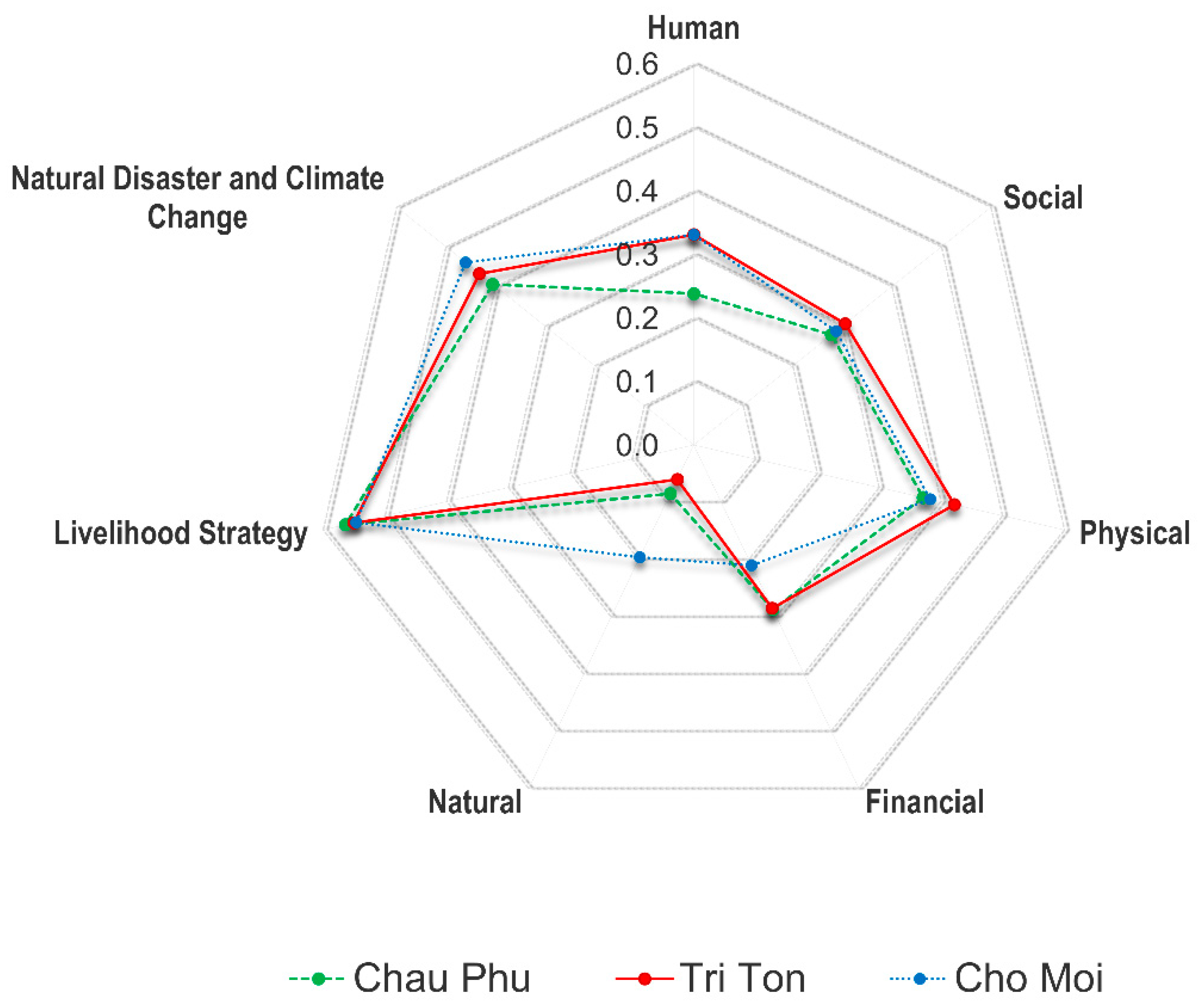
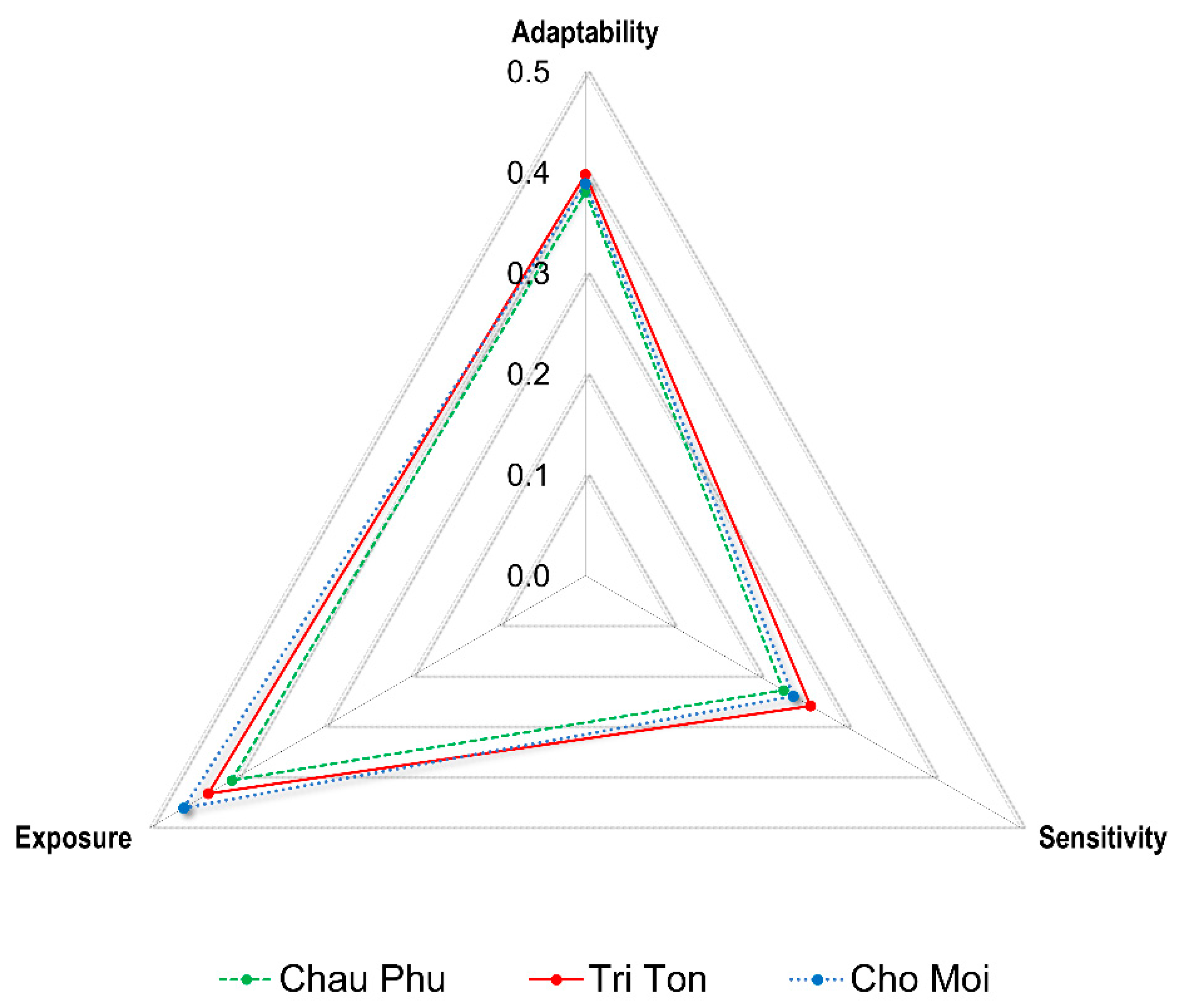
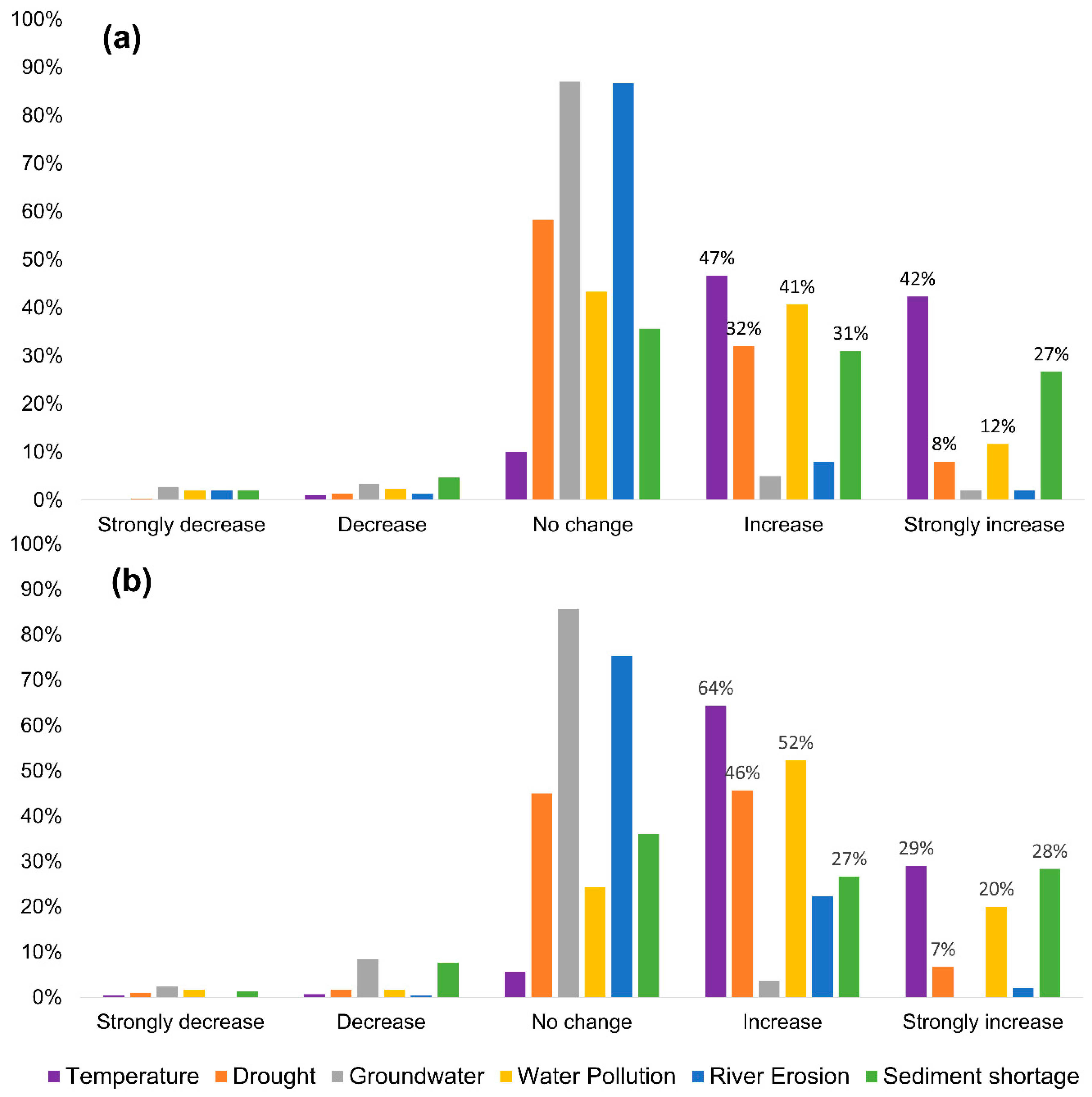
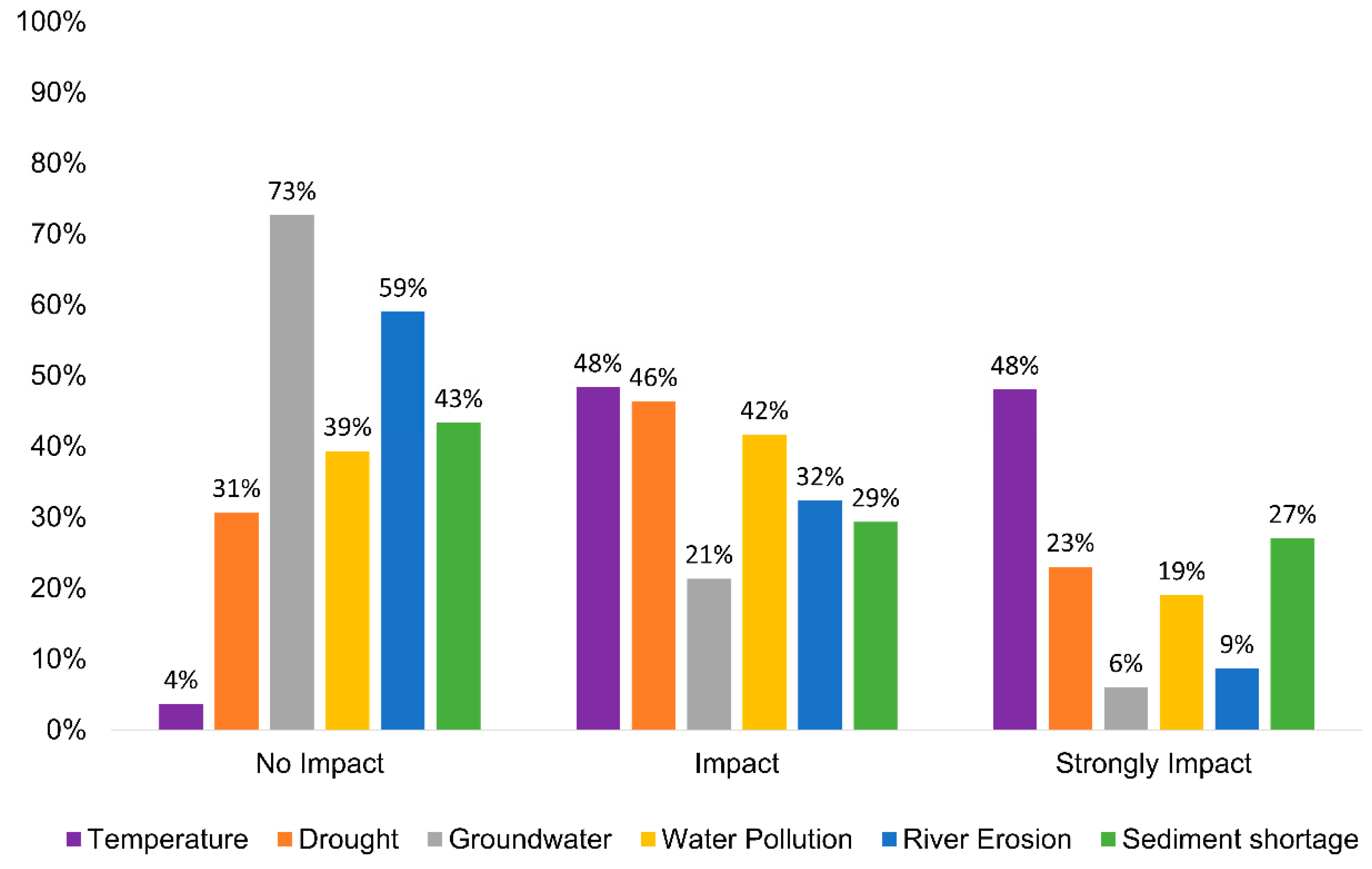
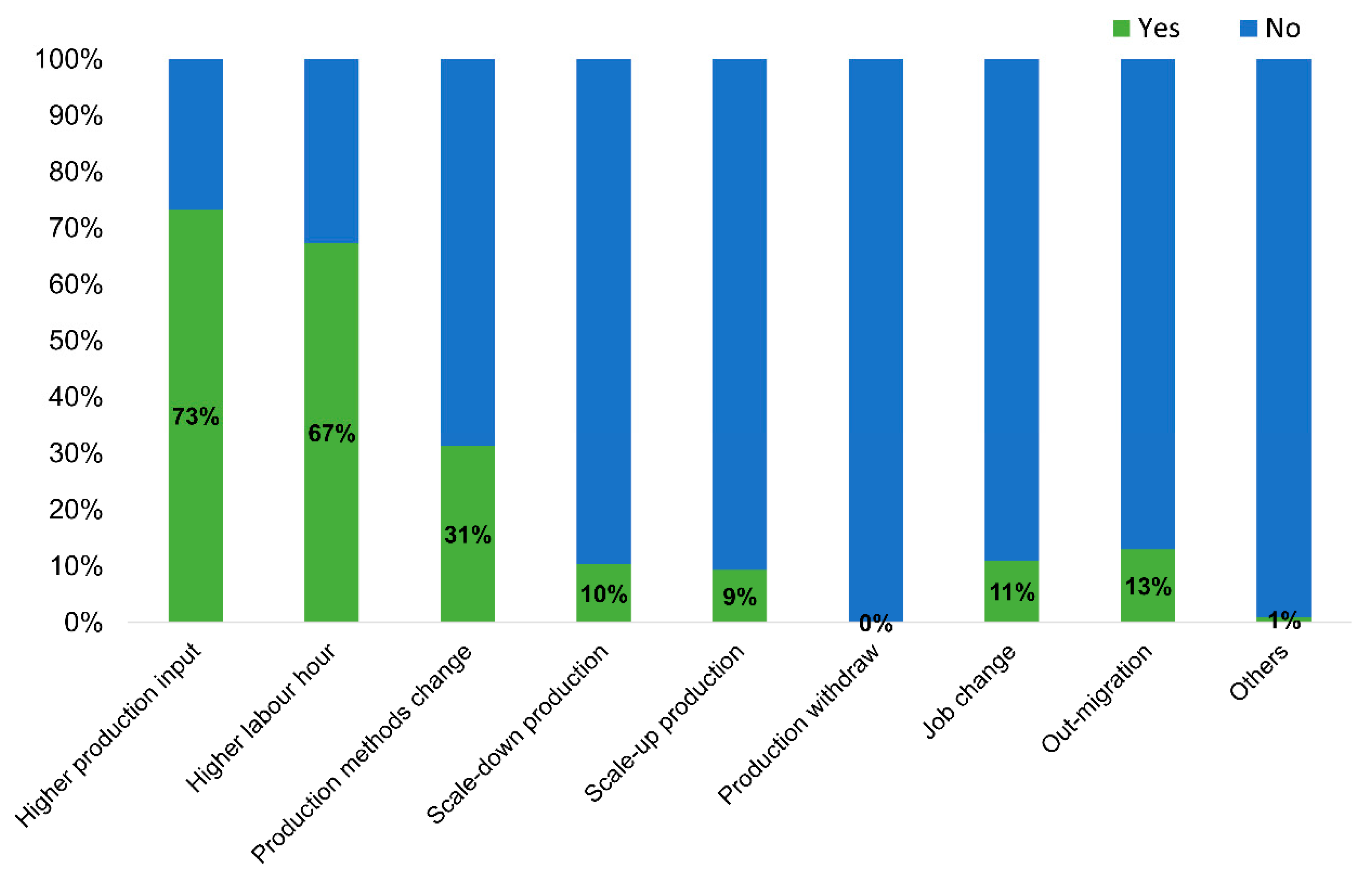
| Characteristics | Chau Phu (n = 120) | Tri Ton (n = 90) | Cho Moi (n = 90) | All (n = 300) |
|---|---|---|---|---|
| Farm household head | ||||
| Age (years) | 51.5 | 47.7 | 51.8 | 50.4 |
| Experience in rice production (years) | 21.2 | 18.3 | 23.3 | 20.9 |
| Education (% completed) | ||||
| Primary | 48 | 52 | 36 | 45 |
| Secondary | 34 | 27 | 43 | 35 |
| Tertiary | 16 | 21 | 16 | 17 |
| Higher education | 3 | 0 | 6 | 3 |
| Gender (%) | ||||
| Male | 93 | 93 | 94 | 94 |
| Female | 7 | 7 | 6 | 6 |
| Number of household members | 4.9 | 4.5 | 4.5 | 4.6 |
| Farm characteristics | 0 | 0 | 0 | 0 |
| Farm size (ha) | 2.3 | 4.3 | 1.9 | 2.8 |
| Farm laborers | 2.3 | 2.4 | 2.6 | 2.4 |
| Mean yield (ton/ha) | ||||
| Winter–Spring (December–March) | 8.1 | 7.9 | 7.4 | 7.8 |
| Summer–Autumn * (April–July) | 7.0 | 6.4 | 6.3 | 6.6 |
| Autumn–Winter ** (July–December) | 7.2 | 6.5 | 6.5 | 6.7 |
| Selling price (USD/ton) | ||||
| Winter–Spring (December–March) | 241 | 244 | 236 | 240 |
| Summer–Autumn * (April–July) | 232 | 242 | 225 | 233 |
| Autumn–Winter ** (July–December) | 243 | 240 | 232 | 238 |
| Annual mean profit/ha (106 VND) | 46 | 40 | 31 | 39 |
| Annual mean profit/ha (USD) | 2074 | 1813 | 1403 | 1763 |
| Key Components | Chau Phu | Tri Ton | Cho Moi |
|---|---|---|---|
| Human | 0.238 | 0.331 | 0.331 |
| Social | 0.278 | 0.306 | 0.287 |
| Physical | 0.371 | 0.422 | 0.383 |
| Financial | 0.288 | 0.285 | 0.210 |
| Natural | 0.085 | 0.060 | 0.196 |
| Livelihood strategy | 0.564 | 0.550 | 0.547 |
| Natural disaster and climate change | 0.406 | 0.433 | 0.461 |
| LVI (overall average) | 0.356 | 0.383 | 0.376 |
| Components | Chau Phu | Tri Ton | Cho Moi |
|---|---|---|---|
| Adaptability | 0.381 | 0.398 | 0.389 |
| Sensitivity | 0.227 | 0.258 | 0.239 |
| Exposure | 0.406 | 0.433 | 0.461 |
| LVI-IPCC (overall average) | 0.006 | 0.009 | 0.017 |
Publisher’s Note: MDPI stays neutral with regard to jurisdictional claims in published maps and institutional affiliations. |
© 2020 by the authors. Licensee MDPI, Basel, Switzerland. This article is an open access article distributed under the terms and conditions of the Creative Commons Attribution (CC BY) license (http://creativecommons.org/licenses/by/4.0/).
Share and Cite
Tran, D.D.; Quang, C.N.X.; Tien, P.D.; Tran, P.G.; Kim Long, P.; Van Hoa, H.; Ngoc Hoang Giang, N.; Thi Thu Ha, L. Livelihood Vulnerability and Adaptation Capacity of Rice Farmers under Climate Change and Environmental Pressure on the Vietnam Mekong Delta Floodplains. Water 2020, 12, 3282. https://doi.org/10.3390/w12113282
Tran DD, Quang CNX, Tien PD, Tran PG, Kim Long P, Van Hoa H, Ngoc Hoang Giang N, Thi Thu Ha L. Livelihood Vulnerability and Adaptation Capacity of Rice Farmers under Climate Change and Environmental Pressure on the Vietnam Mekong Delta Floodplains. Water. 2020; 12(11):3282. https://doi.org/10.3390/w12113282
Chicago/Turabian StyleTran, Dung Duc, Chau Nguyen Xuan Quang, Pham Duy Tien, Pham Gia Tran, Pham Kim Long, Ho Van Hoa, Ngo Ngoc Hoang Giang, and Le Thi Thu Ha. 2020. "Livelihood Vulnerability and Adaptation Capacity of Rice Farmers under Climate Change and Environmental Pressure on the Vietnam Mekong Delta Floodplains" Water 12, no. 11: 3282. https://doi.org/10.3390/w12113282
APA StyleTran, D. D., Quang, C. N. X., Tien, P. D., Tran, P. G., Kim Long, P., Van Hoa, H., Ngoc Hoang Giang, N., & Thi Thu Ha, L. (2020). Livelihood Vulnerability and Adaptation Capacity of Rice Farmers under Climate Change and Environmental Pressure on the Vietnam Mekong Delta Floodplains. Water, 12(11), 3282. https://doi.org/10.3390/w12113282






